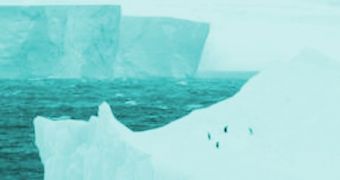Marine researchers at the University of California in San Diego's (UCSD) Scripps Institution of Oceanography propose in a new study that some of the collapse events that affected the Antarctic ice sheet in 2009 may have been triggered by extremely long oceanic waves. Lead scientists Peter Bromirski says that the waves form alongside the Pacific coasts of the Americas, and that they impact the Southern Continent with immense strength, potentially contributing to their catastrophic decline.
The main culprit that triggers this correlation, the expert states, are storms taking place above the North Pacific. They generate large waves that slam into the coasts of North and South America, where they are transformed into what are known as “infragravity waves.” These are capable of traveling vast distances, and can make their way to Antarctic coasts. Once here, they slam into water-based ice sheets with tremendous force, adding to the effects of global warming and warming oceanic water to destabilize the region, and cause more and more ice to fall into the sea.
Infragravity waves “may be a key mechanical agent that contributes to the production and/or expansion of the pre-existing crevasse fields on ice shelves,” the expert says. He conducted the investigation with funding from the California Department of Boating and Waterways, and the US National Science Foundation (NSF). Coauthors of the study include Olga Sergienko, from the Princeton University and Douglas MacAyeal, from the University of Chicago. Details of the work appear in the latest issue of the respected scientific journal Geophysical Research Letters.
For the research, the team turned to data collected by the seismometers on the Ross Ice Shelf. They included these pieces of information into a model designed specifically to identify signals generated by infragravity waves, coming in from as far of as British Columbia and Northern California. They also simulated the stress that ice shelves are subjected to every time one of these wave strikes. They “may produce ice-shelf fractures that enable abrupt disintegration of ice shelves that are also affected by strong surface melting,” the investigators write in their journal entry.
The Scripps Institution of Oceanography is one of the oldest, largest and most important centers for global science research and education in the world. The National Research Council has ranked Scripps first in faculty quality among oceanography programs nationwide. Now in its second century of discovery, the scientific scope of the institution has grown to include biological, physical, chemical, geological, geophysical and atmospheric studies of the Earth as a system

 14 DAY TRIAL //
14 DAY TRIAL //